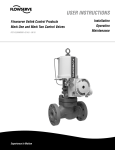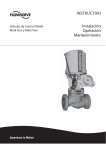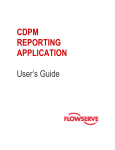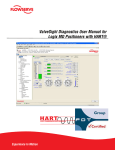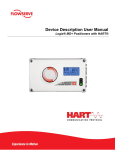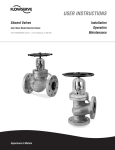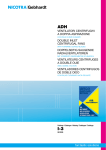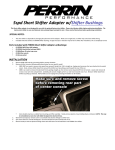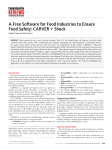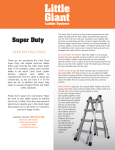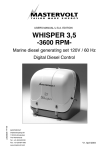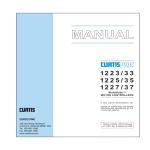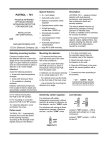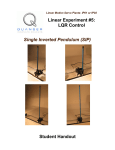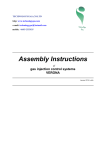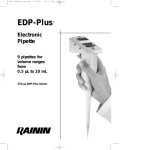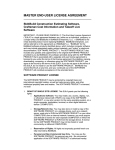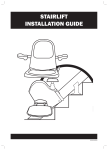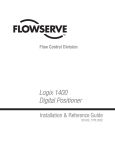Download Valtek Mark One
Transcript
USER INSTRUCTIONs User instructions - Mark One - VLENIM0001-01 07.07 ® Valtek Mark One and Mark Two Control Valves Installation Operation Maintenance User instructions - Mark One - VLENIM0001-01 07.07 ® Contents 1. General Information 2. Unpacking 3. Installation 4. Quick Check 5. Valve Maintenance 6. Disassembly and Inspection 7. Assembly and Installation 8. Severe Service Trim Options 8.1. CavControl 8.2. ChannelStream 8.3. MegaStream 8.4. Stealth 8.5. TigerTooth Figures Figure 1 – Mark One Control Valve Body Assembly Figure 2 – Pressure Balanced Mark One Control Valve Body Assembly Figure 3 – Exploded View Mark One Body Assembly Figure 4 – Soft Seat Assembly Figure 5 – Actuator Stem / Stem Clamp Alignment Figure 6 – Mark One with CavControl Trim Body Assembly Figure 7 – Mark One with ChannelStream Trim Body Assembly Figure 8 – Mark One with MegaStream Trim Body Assembly Figure 9 – Mark One with Stealth Trim Body Assembly Figure 10 – Mark One with TigerTooth Trim Body Assembly Tables Table I – Common Lubricants Table II – Suggested Bonnet Bolting Torque Values Table III – Troubleshooting Chart User instructions - Mark One - VLENIM0001-01 07.07 ® 1. General Information 1.1. Using The following instructions are designed to assist in unpacking, installing and performing maintenance as required on Flowserve products. Product users and maintenance personnel should thoroughly review this bulletin prior to unpacking, installing, operating, or performing any maintenance. In most cases, Flowserve valves, actuators and accessories are designed for specific applications (e.g. with regard to medium, pressure, and temperature). For this reason, they should not be used in other applications without first contacting the manufacturer. The product Installation, Operation, and Maintenance Instructions provides important additional safety information. 1.2. 1.3. 1.3.1. STOP! Applicability The following instructions are applicable to the maintenance and installation of Flowserve Valtek Mark One and Two control valves. These instructions cannot claim to cover all details of all possible product variations, nor can they provide information for every possible example of installation, operation or maintenance. This means that the instructions normally include only the directions to be followed by qualified personal using the product for its defined purpose. If there are any uncertainties in this respect, particularly in the event of missing product-related information, clarification must be obtained via the appropriate Flowserve sales office. All Flowserve User Manuals are available at www.flowserve.com. Terms Concerning Safety The safety terms DANGER, WARNING, CAUTION and NOTE are used in these instructions to highlight particular dangers and/or to provide additional information on aspects that may not be readily apparent. DANGER: Indicates that death, severe personal injury and/or substantial property damage will occur if proper precautions are not taken. WARNING: Indicates that death, severe personal injury and/or substantial property damage can occur if proper precautions are not taken. CAUTION: Indicates that minor personal injury and/or property damage can occur if proper precautions are not taken. NOTE: Indicates and provides additional technical information, which may not be obvious, even to qualified personnel. 1.3.2. Compliance with other notes, which may not be particularly emphasized, with regard to transport, assembly, operation and maintenance and with regard to technical documentation (e.g. in the operating instructions, product documentation, or on the product itself) is essential, in order to avoid faults, which can directly or indirectly cause severe personal injury or property damage. 1.4. Protective Clothing DANGER: Flowserve products are often used in problematic applications (e.g. under extremely high pressures with dangerous, toxic or corrosive mediums). When performing service, inspection, or repair operations, always ensure that the valve and actuator are depressurized and that the valve has been cleaned and is free from harmful substances. In such cases, pay particular attention to personal protection (e.g. protective clothing, gloves, glasses etc.). 1.5. Qualified Personnel Qualified personnel are people who, on account of their training, experience and instruction and their knowledge of relevant standards, specifications, accident prevention regulations and operating conditions, have been authorized by those responsible for the safety of the plant to perform the necessary work and who can recognize and avoid possible dangers. Contact your local Flowserve representation for a schedule of training schools. 1.6. Spare Parts Use only Flowserve original spare parts. Flowserve cannot accept responsibility for any damages that occur from using spare parts or fastening materials from other manufactures. If Flowserve products (especially sealing materials) have been on store for long periods of time check them for corrosion or deterioration before putting them into use. 1.7. Service / Repair To avoid possible injury to personnel or damage to products, safety terms must be strictly adhered to. Modifying this product, substituting non-factory parts, or using maintenance procedures other than those outlined in these Installation, Operation, and Maintenance Instructions could drastically affect performance, be hazardous to personnel and equipment, and may void existing warranties. Between the actuator and the valve there are moving parts. To avoid injury, Flowserve provides pinch-point-protection in the form of cover plates, especially where side-mounted posi- User instructions - Mark One - VLENIM0001-01 07.07 ® Plug (Item # 50) Upper Guide (Item # 87) Upper Packing (Item # 88) Body Bolting (Item # 108/114) Bonnet Flange (Item # 70) Bonnet (Item # 40) Packing Spacers (Item # 94-99) Lower Packing (Item # 83) Lower Guide (Item # 83) Bonnet Gasket (Item # 58) Body (Item # 1) Seat Ring Seat Retainer (Item # 20) Seat Gasket (Item # 30) (Item # 55) Figure 1: Mark One Control Valve Body Assembly User instructions - Mark One - VLENIM0001-01 07.07 ® STOP! tioners are fitted. If these plates are removed for inspection, service or repair special attention is required. After completing work the cover plates must be refitted. Apart from the operating instructions and the obligatory accident prevention directives valid in the country of use, all recognized regulations for safety and good engineering practices must be followed. WARNING: Before products are returned to Flowserve for repair or service, Flowserve must be provided with a certificate that confirms that the product has been decontaminated and is clean. Flowserve will not accept deliveries if a cleaning certificate has not been provided. Return authorization is also required before parts are returned. Contact your local Flowserve representative to obtain return authorization. 1.8. Storage In many cases, Flowserve products are manufactured from stainless steel. Products not manufactured from stainless steel are provided with an epoxy resin coating. This means that Flowserve products are well protected from corrosion. Nevertheless, Flowserve products must be stored adequately in a clean, dry environment. Plastic caps or plywood protectors are fitted to help protect the flange faces and prevent the ingress of foreign materials. These caps should not be removed until the valve is actually mounted into the system. 2. Unpacking 2.1. 2.2. STOP! 2.3. 2.4. While unpacking the valve, check the packing list against the materials received. Lists describing the valve and accessories are included in each shipping container. When lifting the valve from shipping container, use straps through the yoke legs, or the lifting lugs attached to the body bolting for valves over four inch, or the adjusting screw for valves four inch and under. Take care to position lifting straps to avoid damage to the tubing, mounted accessories, or stroke plate. WARNING: When lifting a valve be aware that the centre of gravity may be above the lifting point. Therefore, support must be given to prevent the valve from rotating. Failure to do so can cause serious injury to personnel and damage to the valve and nearby equipment. Contact your shipper immediately if there is shipping damage. Should any problem arise, call your Flowserve representative. 3. STOP! 3.1. 3.2. 3.3. 3.4. 3.5. 3.6. 3.7. Installation DANGER: Before installation check the purchase order number, serial number, and/or the tag number to ensure that the valve and actuator being installed are correct for the intended application. WARNING: The maximum air supply for most Valtek cylinder actuators is 150 psi (10.3 bar). In some cases, the air supply must be limited to less than 150 psi (10.3 bar). This is indicated on a sticker found near the upper air port on the actuator cylinder. An air regulator should be installed to ensure the supply pressure does not exceed the actuator design pressure indicated on the sticker. CAUTION: Do not insulate extensions that are provided for hot or cold services. CAUTION: On valves equipped with air filters, the air filter must point down to perform properly. NOTE: Selecting the proper fastener material is the responsibility of the customer. Typically, the supplier does not know what the valve service conditions or environment may be. Flowserve‘s standard body bolting material is B7/2H. B8/8 (stainless steel) is optional for applications more than 800° F / 425° C and with stainless steel or alloy body valves. The customer therefore must consider the material‘s resistance to stress corrosion cracking in addition to general corrosion. As with any mechanical equipment, periodic inspection and maintenance is required. For more information about fastener materials, contact your Flowserve representative. Pipelines must be correctly aligned to ensure that the valve is not fitted under tension. Fire protection must be provided by the user. Before installing the valve, clean the line of dirt, welding chips, scale and other foreign material. Whenever possible, the valve should be installed in an upright position. Vertical installation permits easier valve maintenance. This is also important for cryogenic applications to keep the packing isolated from the flowing medium, permitting the packing temperature to remain close to ambient temperature. Be sure to provide proper overhead clearance for the actuator to allow for disassembly of the plug from the valve body. Refer to the appropriate actuator User Instructions for proper clearances. Actuator User Instructions are available at www.flowserve.com. Double-check flow direction to be sure the valve is installed correctly. Flow direction is indicated by the arrow attached to the body. If welding the valve into the line, use extreme care to avoid excess heat buildup in the valve. User instructions - Mark One - VLENIM0001-01 07.07 ® Figure 2: Pressure Balanced Mark One Control Valve Body Assembly 3.8. STOP! 3.9. 4. 4.1. If the valve has separable end flanges, verify that the half rings are installed on the valve body before bolting the valve into the line. WARNING: Failure to install half rings on the valve body can cause serious personal injury. Connect the air supply and instrument signal lines. Throttling control valves are equipped with a valve positioner. Refer to the appropriate positioner bulletin for connections, maximum air supplies, and maintenance instructions. An air filter should be installed before the positioner. All connections must be free of leaks. CAUTION: On valves equipped with air filters, the air filter must point down to perform properly. Quick-check Prior to start-up, check the control valve by following these steps: Stroke the valve and observe the plug position indicator on the stem clamp compared to the stroke indica- STOP! 4.2. 4.3. 4.4. tor plate. The plug should change position in a smooth, linear fashion. NOTE: Due to excessive friction a dry graphite packing can cause the plug stem to move in a jerky fashion. Lubrication of graphite packing will provide smoother stroking. Lubrication can be done by using a bonnet lubricator or by liberally coating each packing ring by hand during installation. Please refer to Table I for lists of common lubricants. WARNING: Keep hands, hair and clothing away from all moving parts when operating the valve. Failure to do so can cause serious injury. Check for full stroke by making appropriate instrument signal changes. Check all air connections for leaks. Check packing box bolting for the correct adjustment. Refer to the packing installation manual for specific details on maintaining the style of packing supplied. User instructions - Mark One - VLENIM0001-01 07.07 ® 4.5. 5. 5.1. 5.2. 5.3. 5.4. 5.5. 5.6. CAUTION: Do not overtighten packing. This can cause excessive packing wear, high stem friction that may impede plug movement and can damage the packing. Over-tightening packing will not improve the stem seal unless the packing has been previously damaged. Damaged packing should be replaced. Make sure the valve fails in the correct direction in case of air failure. This is done by turning off the air supply and observing the failure direction. Valve Maintenance At least once every six months, check for proper operation by following the preventative maintenance steps outlined below. These steps can be performed while the valve is in-line and, in some cases, without interrupting service. If an internal problem is suspected, refer to Section 6, Valve Disassembly and Inspection. Look for signs of gasket leakage through the end flanges and bonnet. Re-torque flange and bonnet bolting (if required). Refer to Table II for bonnet bolt torque values. Examine the valve for damage caused by corrosive fumes or process drippings. Clean valve and repaint areas of severe oxidation. Check packing box bolting for proper tightness and packing leakage. If packing leakage is noticed, packing maintenance is required. Refer to the packing installation manual (document number VLAIM040) for specific details on maintaining the style of packing supplied. CAUTION: Do not overtighten packing. This can cause excessive packing wear and high stem friction that may impede stem movement. Packing that is tightened too tight will typically not seal correctly. If the valve is supplied with a lubricator fitting, check lubricant supply and add lubricant if necessary. See Table I for common lubricants. If possible, stroke the valve and check for smooth, fullstroke operation. Unsteady stem movement could indicate an internal valve problem. STOP! 5.7. 5.8. 5.9. 5.10. 5.11. 5.12. 5.13. 5.14. NOTE: Due to excessive friction a dry graphite packing can cause the plug stem to move in a jerky fashion. Lubrication of graphite packing will provide smoother stroking. Lubrication can be done by using a bonnet lubricator or by liberally coating each packing ring by hand during installation. Please refer to Table I for lists of common lubricants. WARNING: Keep hands, hair and clothing away from all moving parts when operating the valve. Failure to do so can cause serious injury. Make sure positioner linkage and stem clamp are securely fastened. If the stem clamp is loose, check plug thread engagement (refer to the “Reassembly and Installation” section for the correct procedure on aligning the plug with the seat). Tighten stem clamp nut. NOTE: Refer to the appropriate User Manuals when adjusting positioners and providing maintenance to actuators. Current User Manuals are available at www.flowserve.com. Verify that the takeoff arm and follower arm are not binding at either end of the stroke. The follower arm attached to the positioner should be free to move slightly when the valve is at both ends of the stroke. Ensure all accessories, brackets and bolting are securely fastened. If possible, remove air supply and observe actuator for correct fail-safe action. Check rubber actuator bellows for splits, cuts or wear. Spray a soap solution around the actuator cylinder retaining ring and actuator stem guide to check for air leaks through the O-rings. Clean any dirt and other foreign material from the plug stem. If an air filter is supplied, check and replace cartridge if necessary. Drain any moisture accumulated in the air filter. Table I: Common Packing Lubricants Lubricant Manufacturer Temperature Range °F °C Application Description Krytox® E.I DuPont -5 to 550 -20 to 285 Fluorinated general purpose grease; handles common liquids and gasses; good lubricity in harsh mediums; nonflammable, chemically inert; will not harm plastic or metal parts GP 460 Acheson Colloids Company 32 to 1000 0 to 540 Graphite in petrolatum; high pressure; anti-galling; graphite remains above 600°F / 316°C 725 Chesterton 32 to 2600 0 to 1425 Nickel, Aluminum and graphite in oil suspension;provides protection with an ultra-thin coating of nickel particles User instructions - Mark One - VLENIM0001-01 07.07 ® Gland Bolting (Items #109, 117) Gland Flange (Item #80 ) Body Bolting (Items #108, 114) Bonnet Flange (Item #70) Upper Guide Upper Packing (Item #87) (Item #88) Packing Spacers Lower Packing (Item #88) Yoke Half Clamps & Yoke Clamp Bolts (Items #76, 107,118) (Item #94-99) Lower Guide (Item #83) Bonnet (Item #40) Bonnet Gasket (Item #58) Plug (Item #50) Seat Retainer (Item #30) Seat Ring Seat Gasket (Item #20) (Item #55) Body (Item #1) Figure 3: Exploded View Mark One Body Assembly User instructions - Mark One - VLENIM0001-01 07.07 ® 6. 6.1. STOP! 6.2. 6.3. STOP! 6.3.1. 6.3.2. 6.3.3. 6.3.4. 6.4. 6.5. Valve Disassembly To disassemble the valve body, refer to Figures 1, 2 and 3 then proceed as follows: WARNING: Depressurize line to atmospheric pressure and drain all fluids before working on the valve. Failure to do so can cause serious injury. If valve is air-to-open, apply air under the piston to lift the plug off the seat before taking the valve apart. If valve is air-to-close, proceed to step 6.3. Remove the bonnet flange bolting and lift actuator, bonnet and plug out of the valve. Once removed, the actuator, bonnet and plug assembly (called the top works) should be lowered and blocked to prevent rolling during the disassembly of the top works. WARNING: Danger exists in removing the actuator, bonnet and plug, especially if a pressure balanced plug is used. The pressure balanced sleeve may stick to the plug and fall during disassembly, causing possible serious injury and damage to the valve or nearby equipment. If sleeve is observed sticking to the plug, steps 6.3.1 to 6.3.4 should be consulted. CAUTION: Heavy actuators may require a hoist. Lift the valve with the yoke legs using a lifting strap and a hoist. Great care should be taken to lift the actuator and plug straight out of the body to avoid damage to the plug and seat. If the sleeve is observed sticking to the plug during removal, fully extend the plug by applying air above the piston, allowing the sleeve to remain in the body and the bonnet to rise above the body. In the gap between the top of the sleeve and the bottom of the bonnet, place wooden blocking of equal thickness in at least three places. The wooden blocks must not extend in far enough that they interfere with plug movement. The plug must be allowed to stroke up to the bonnet. By applying air below the piston, retract the plug until the plug head is freed from the sleeve. Once the plug is free from the sleeve, remove the plug and bonnet assembly from the body. Lift the pressure balanced sleeve out of the valve body using lifting points on the top of the sleeve. NOTE: In many small Mark One valves, the seat retainer and pressure balancer sleeve are one and the same part. In larger valves, there are separate pressure balancer sleeves and seat retainers. Lift retainer, seat ring and gaskets free of the body. Care must be taken not to damage the gasket surfaces in the body when the gaskets are removed. Valves with soft seats (see figure 4) require the seat ring to be inspected and possibly disassembled. Check to see that seating surfaces on the plug and seat assemblies are free of damage. If the seat insert is worn, remove it from the assembly. Since the plug 6.6. STOP! 6.7. 6.8. 6.9. seating surface does not come in contact with the seat insert retainer, it is not necessary to correct any minor damage to that part. The plug seating surface can be re-machined to a 30 degree angle. Lapping is not required when proper reassembly procedures are followed. Loosen the stem clamp and unscrew the plug from the actuator stem. WARNING: Danger exists when working with large valves and heavy parts. Take care to properly support large parts to avoid damage to the parts of nearby equipment or personnel. Remove the packing gland bolting, yoke clamps and remove the actuator. If the seat surfaces need re-machining, both surfaces on plug and seat ring must be reworked. The seat angle on the plug is 30 degrees (36 degrees for CavControl and ChannelStream valves); the seat ring, 33 degrees. Lapping is not necessary if proper assembly procedures are followed. CAUTION: If re-machining, protect the stem while turning. Ensure concentration of the seat surface with the plug stem (or outside diameter of the seat ring, if machining the seat). To replace packing or change the packing box configuration, push out packing, spacer and guides from underneath the bonnet with a dowel around 0.13 inch (3.3 mm) larger in diameter than the plug stem. Table II: Suggested Bonnet Bolting Torque Values Bolt Size (inches) Bolt/Stud Material Carbon Steel Stainless Steel ft-lbs Nm ft-lbs Nm 5/8 80 108 50 68 3/4 140 190 90 122 7/8 230 312 150 203 1 350 475 220 298 1 1/8 510 691 330 447 1 1/4 730 990 460 624 1 3/8 990 1342 630 854 1 1/2 1320 1790 840 1139 1 5/8 1710 2318 1080 1464 1 3/4 2170 2942 1400 1898 1 7/8 2700 3661 1700 2305 2 3350 4542 2100 2847 * All values are ±10% User instructions - Mark One - VLENIM0001-01 07.07 ® STOP! 3OFT3EAT2ETAINER 6.10. 3OFT3EAT 3EAT2ING 6.11. 7. Figure 4: Soft Seat Assembly 7.1. 7.2. Figure 5: Actuator Stem / Stem Clamp Alignment 7.3. 7.4. 10 WARNING: For valves equipped with separable end flanges, do not machine body gasket surfaces. Machining could cause failure of the separable flange lip causing end gasket leakage and valve failure. CAUTION: When using separable end flanges and spiral wound gaskets, use gaskets with outer backup rings. Failure to do so could result in excess stress in some applications. Check to see the seating surfaces on both the seat ring and plug are free of damage to ensure tight shutoff. Make sure the gasket surfaces on the seat ring, bonnet and body are clean and undamaged. Examine the plug stem and bonnet bore for scoring, scratches, pitting or other damage. Refer to the appropriate actuator User Manual for detailed instructions on actuators. Assembly and Installation NOTE: Separate User Manuals with instructions on assembling actuators, positioners and other equipment can be found on www.flowserve.com. Review any relevant User Manual before proceeding NOTE: It is recommended that all soft goods are replaced when rebuilding Mark One and Two control valves. Soft goods include gaskets, pressure balanced seals, soft seat inserts, guide liners and packing seats. Replacing these parts helps to ensure proper functioning of the control valve. To reassemble the valve body, refer to figures 1, 2 and 6 thru 9 and proceed as follows: If the packing has been removed, refer to the appropriate packing User Manual (document number VLAIM040) and reinstall the packing and lower guide exactly as shown. Make sure at least 1/8 inch is left at the top of the packing box for the top guide to sit into the bonnet. Different packing spacers permit a wide variety of packing configurations, such as twin seal and vacuum-pressure packing. CAUTION: Valves with extended bonnets or metal bellows seals must not have lower packing installed. Instead, lower packing rings should be installed with the upper set. Lower packing installed in extended bonnets or metal bellows seal valves will diminish the integrity of the packing assembly. NOTE: Guide liners should be replaced each time the valve packing is replaced. Do not rebuild the valve without the correct guide liners. Re-insert the plug stem into the packing box, being careful not to score the plug stem or the guides. Reinstall pressure balanced seals if required. Turn actuator back onto the plug, without turning the plug inside the bonnet. Make sure the gland flange and bonnet flange are in place before engaging the plug stem and actuator stem threads. The gland flange User instructions - Mark One - VLENIM0001-01 07.07 ® 7.5. 7.6. 7.7. 7.8. 7.9. 7.9.1. 7.9.2. chamfer must be face down towards the valve body. Leave approximately three to four plug stem threads exposed. Attach yoke clamp and gland flange bolting. For valves with a 2-inch spud, be sure the half rings are in place between the yoke and bonnet. Firmly tighten yoke clamp bolting. The packing box nuts should be just over finger tight. NOTE: Do not allow the gland flange to contact and gall the polished plug stem. Install new bonnet and seat gaskets with the bevelled edge up for Teflon gaskets. Insert the seat ring into the body with the step side down. When the seat ring is properly in place it will turn easily in the body. Place the seat retainer into the body with the thin end of the cathedral window down. Most retainers have an arrow pointing up to verify correct installation. For pressure balanced valves, install the pressure balanced sleeve gasket. Ensure that severe service retainers are correctly indexed by turning the retainer in the body. Correctly aligned retainers should turn easily. CAUTION: Installing seat retainers upside down can damage the control valve parts. CAUTION: Seat rings, retainers and pressure balanced sleeves must be installed squarely into the body to function correctly. To check to make sure the parts are installed correctly, rotate these parts a little by hand. The parts should rotate freely without binding. NOTE: When the seat retainer has only two ports, one of the two ports should be aligned with the upper port of the body. Place air under the actuator piston on air-to-open valves to retract the plug. Lower the plug and bonnet squarely into the body. Be careful not to scratch or gall the plug as it enters the body. To properly align the seat ring and plug, first bring the bonnet bolting to finger-tightness. With pneumatic actuators, apply air pressure above the piston to seat the plug in the seat ring. Proceed to step 7.10. With electric or hydraulic actuators, move the actuator stem down until it is completely extended. Next, retract the actuator stem 1/8 inch (3.2 mm). Install the stem clamp onto the plug stem and actuator stem and tighten the associated bolting. Move the actuator stem completely down. Adjust actuator limit switches according to the actuator’s operating manual. The actuator limit switches will need to be readjusted once the body bolting has been tightened. NOTE: Step 7.10 applies only to valves with pneumatic actuators. If an electric or hydraulic actuator is used, return the plug to the mid-stroke position and proceed to tighten. 7.10. 7.11. 7.12. 7.13. 7.14. 7.15. CAUTION: Failure to return the plug to a mid-stroke position (electric or hydraulic operators only) will cause damage to the actuator and / or the valve during the bonnet tightening sequence. This is due to the inability of most electric / hydraulic actuators to accommodate the 1/16 inch / 1.60 mm back-drive during the tightening sequence. For air-to-close valves, skip this step and go to step 7.11. For air-to-open valves, check for proper plug seating as follows: When proper seating occurs, the bonnet flange will be forced up against the finger-tight body bolting with such force that it will be impossible to move the flange. If proper seating does not occur, the bonnet flange can be wiggled with light hand force for small valves and light wrench force for larger valves. Should this occur, place air under the actuator piston and retract the actuator to approximate midstroke position. Turn the plug out of the actuator plug stem one additional thread and repeat above seating procedure. When the bonnet flange becomes tight against the finger-tight body bolting, the plug is properly seated. If necessary, repeat above procedure until proper seating occurs. Stroke the valve open and closed several times to center the seat ring. Retract the plug (open position). Begin tightening the bonnet flange bolting in a manner that will keep the bonnet flange square / parallel with the body. Tighten the first bolt 1/6 turn, or one nut flat, then tighten the bolt directly opposite 1/6 turn and so on around the flange. Firmly tighten all bolts evenly and completely to compress the bonnet gasket and to seat the bonnet. Torque the bonnet bolts to the suggested torque values in Table II. The bonnet will seat metal to metal with the body when the bonnet bolts are correctly torqued into place Apply air over the piston to seat the plug. For all throttling valves, adjust the stem clamp so that with full instrument signal to the positioner the full signal scribe line on the positioner cam points to the centre of the cam roller bearing. CAUTION: Make sure the slots of the stem clamp are perpendicular to the bolting. See Figure 5. NOTE: For on / off valves, the bottom of the stem clamp should simply be lined up with the bottom of actuator stem ± 1/16 inch (1.6 mm). Tighten the stem clamp bolting. Proper tightness is important since this adjustment secures the actuator stem to the plug stem. Adjust the stroke plate so the stem clamp points to the “closed” position. If the valve has been taken out of the line, make sure the flow arrow indicates proper flow direction upon reinstallation. Adjust and test all accessories. 11 User instructions - Mark One - VLENIM0001-01 07.07 ® 8. 8.1. 8.1.1. Figure 6 Mark One with CavControl Trim Body Assembly Figure 7 Mark One with ChannelStream Trim Body Assembly 12 Severe Service Trim Options CavControl CavControl replaces the standard Mark One retainer with a drilled, stepped-hole retainer, see Figure 6. The plug and bonnet have dimensional differences from the standard Mark One design. Assembly and disassembly of the valve follows the standard procedures. 8.1.2. CavControl retainers, plugs and seats should be examined for excessive cavitation damage when disassembled. Holes in the retainer should be checked for worn or eroded surfaces. Check for plugged holes in the retainer. Plugs and retainer mating surfaces should be examined for damage. Repair and replacement of damaged parts is critical to maintaining cavitation resistance. CAUTION: To function properly, CavControl is always installed flow over. 8.2. ChannelStream 8.2.1. ChannelStream replace the standard retainer with multiple sleeves pinned together, see Figure 7. The plug, seat ring, and bonnet have dimensional differences from the standard Mark One design. Assembly and disassembly of the valve follows the standard procedures. 8.2.2. ChannelStream retainers, plugs and seats should be examined for excessive cavitation damage when disassembled. The inner holes in the retainer should be checked for wear or erosion, evidence of erosion should require that the retainer is disassembled. Plugs and retainer mating surfaces should be examined for damage. Repair and replacement of damaged parts is critical to maintaining cavitation resistance. 8.2.3. ChannelStream retainers should be cleaned of debris whenever the valve is opened. 8.2.4. Use the following steps if the retainer must be disassembled to clean or inspect for damage. ChannelStream retainers in pressure classes 900 and higher cannot be disassembled in the field. Contact your local Flowserve representative for service options. 8.2.4.1. Carefully grind away the small bead welds located on the assembly pins near the top of the retainer. This will loosen the pins which hold the retainer together. Using a punch, locate the hole in the retainer opposite the pin and drive each pin out of the retainer. 8.2.4.2. The retainer can now be inspected for damage or cleaned. 8.2.4.3. Reassemble the retainer sleeves and reinstall the pins making sure to leave an open hole opposite each pin so that the pin can be driven out in the future. Apply a small (1/8 inch) bead of weld to each pin to hold it in place. NOTE: Do not weld more than the approved 1/8 inch. Excessive heat from the bead welds that are too large can disturb critical retainer tolerances. Use an appropriate weld rod which is compatible with the retainer material. If uncertain, contact the factory. CAUTION: To function properly, ChannelStream is always installed flow over. User instructions - Mark One - VLENIM0001-01 07.07 ® 8.3. MegaStream 8.3.1. MegaStream replaces the standard Mark One retainer with a drilled hole retainer, see Figure 8. The plug and bonnet are typically identical to the standard Mark One design. Assembly and disassembly of the valve follows the standard procedures. MegaStream retainers, plugs and seats should be examined for damage when disassembled. Holes in the retainer should be checked for worn or eroded surfaces. Check for plugged holes in the retainer. Multistage MegaStream retainers cannot be disassembled. Repair and replacement of damaged parts is critical to maintaining noise control. CAUTION: To function properly, MegaStream is always installed flow under. 8.3.2. Figure 8 Mark One with MegaStream Trim Body Assembly 8.4. Stealth 8.4.1. Stealth replaces the standard Mark One retainer with a braised, stacked-disk retainer, see Figure 9. Several of the parts, including the plug, seat ring and bonnet have dimensional differences from the standard Mark One design. Assembly and disassembly of the valve follows the standard procedures. Stealth retainers, plugs and seats should be examined for damage when disassembled. Holes in the retainer should be checked for worn or eroded surfaces. Check for plugged holes in the retainer. Stealth retainers cannot be disassembled. Repair and replacement of damaged parts is critical to maintaining noise control. CAUTION: With rare exception, to function properly, Stealth is always installed flow under. When reinstalling Stealth retainers, care must be given to orientating the retainer correctly. Stealth retainers have an arrow that must be aligned with the valve outlet. 8.4.2. 8.4.3 Figure 9 Mark One with Stealth Trim Body Assembly 13 User instructions - Mark One - VLENIM0001-01 07.07 ® 8.5. TigerTooth 8.5.1. TigerTooth replaces the standard Mark One retainer with a welded or pinned, stacked-disk retainer, see Figure 10. Several of the parts, including the plug, seat ring and bonnet have dimensional differences from the standard Mark One design. Assembly and disassembly of the valve follows the standard procedures. TigerTooth retainers, plugs and seats should be examined for damage when disassembled. The retainer should be checked for worn or eroded surfaces. Check for debris lodged in the retainer. Pinned TigerTooth retainers can be disassembled and cleaned. Care should be taken when reassembling to stack up the discs in the same order. Each disc has been etched with a number for that purpose. Welded TigerTooth retainers should not be disassembled outside a qualified service centre. Repair and replacement of damaged parts is critical to maintaining noise and/or cavitation control. CAUTION: With rare exception, to function properly, TigerTooth is always installed flow under. 8.5.2. Figure 10 Mark One with TigerTooth Trim Body Assembly 14 User instructions - Mark One - VLENIM0001-01 07.07 ® Table III: Troubleshooting Chart Problem Probable Cause Corrective Action Stem motion impeded 1. Over-tightened packing 1. Adjust the packing box nuts to slightly over finger-tight 2. Service temperature is beyond operating limits of trim design 2. Reconfirm service conditions and contact factory 3. Inadequate air supply 3. Check for leaks in air supply or instrument signal system; tighten loose connections and replace leaky lines 4. Malfunctioning positioner 4. Refer to positioner User Instructions 1. Improperly tightened bonnet 1. Refer to step 7.11 Assembly and Installation section for correct tightening procedure 2. Worn or damaged seat ring 2. Disassemble valve and replace or repair seat ring 3. Worn or damaged seat or bonnet gasket 3. Disassemble and replace gaskets 4. Inadequate actuator thrust 4. Check for adequate air supply to actuator; if air supply is adequate, reconfirm service conditions and contact factory 5. Incorrectly adjusted plug 5. Refer to steps 7.9 to 7.11 Assembly and Installation section for correct plug adjustment 6. Improper flow direction 6. Refer to original specifications or contact factory 7 Improper . handwheel adjustment acting as a limit-stop 7. Adjust handwheel until plug seats properly 8. Worn or damaged pressure balanced seals 8. Disassemble and replace pressure balanced seals 9. Inadequate air supply pressure 9. Check for leaks in air supply or instrument signal system; tighten loose connections and replace leaky lines 1. Improper plug adjustment, limiting stroke 1. Refer to steps 7.9 to 7.11 Assembly and Installation section for correct plug adjustment 2. Malfunctioning positioner 2. Refer to positioner maintenance instructions 3. Service conditions exceed trim design capacity 3. Verify service conditions and consult factory 4. Incorrect actuator stroke 4. Verify actuator stroke 5. Inadequate air supply pressure 5. Check for leaks in air supply or instrument signal system; tighten loose connections and replace leaky lines 1.Incorrect plug adjustment allowing improper cushion of air between actuator piston and yoke 1. Refer to steps 7.9 to 7.11 Assembly and Installation section for correct plug adjustment 2. Inadequate air supply 2. Check air supply to actuator; repair leaks and remove any restrictions in supply line 3.Trim sized too large for flow rate 3. Verify the service conditions and actuator sizing, install reduced trim 1. Incorrect flow direction 1. Reconfirm direction and, if necessary, correct flow direction through valve 2. Incorrect actuator fail direction 2. Consult actuator User Manual and change fail direction Excessive seat leakage Inadequate flow Plug slams Valve does not fail in correct position 15 User instructions - Mark One - VLENIM0001-01 07.07 ® Flowserve Worldwide Flowserve Flow Control Division 1350 N. Mt. Springs Parkway Springville, UT 84663 USA Phone: 801 489 8611 Fax: 801 489 3719 Flowserve Pte Ltd 12 Tuas Avenue 20 Singapore 638824 Singapore Phone: 65 6879 8900 Fax: 65 6862 4940 Flowserve Australia Pty Ltd. 14 Dalmore Drive Scoresby Victoria 3179 Australia Phone: 61 (3) 9759 3300 Fax: 61 (3) 9759 3301 Flowserve de Venezuela Zona Industrial Av. 68 No. 149B-155 Zona Industrial II Maracaibo, Zulia 1042 Venezuela Phone: 582 61 736.1771 Fax: 582 61 736.1912 Flowserve (Austria) GmbH Control Valves-Villach Operation Kasernengasse 6 9500 Villach Österreich Phone: 43 (0) 4242 41 181 0 Fax: 43 (0) 4242 41181 50 Flowserve India Controls Pvt Ltd. Plot # 4, 1A, Road #8 EPIP Whitefield Bangalore, Karnataka, 560066 India Phone: 91 80 40146200 Fax: 91 80 28410286 FCD VLENIM0001-01 – 07.07 (Replaces VLAIM001-00) To find your local Flowserve representative please use the Sales Support Locator System found at: Flowserve Fluid Motion and Control (Suzhou)Co., Ltd. No.35, Baiyu Road, Suzhou Industrial Park, Suzhou Jiangsu Province, P.R. 215021 China Phone: 86 512 6288 8790 Fax: 86 512 6288 8736 Flowserve Corporation PO Box 209 Al Khobar 31952 Saudi Arabia Phone: 9663 857 3146 Fax: 9665 4915276 Flowserve Unit 1, 12 Director Road Spartan Exit 2 Kempton Park Gauteng 1613 South Africa Phone: 27 (0) 11 923 7300 Fax: 27 (0) 11 974 6420 www.flowserve.com/contact.htm or call USA 801 489-8611 Flowserve Regional Flowserve Canada Corp. 9044 - 18th Street Edmonton, Alberta T6P 1K6 Canada Phone: 780-449-4850 Fax: 780-449-4851 Flowserve Corporation has established industry leadership in the design and manufacture of its products. When properly selected, this Flowserve product is designed to perform its intended function safely during its useful life. However, the purchaser or user of Flowserve products should be aware that Flowserve products might be used in numerous applications under a wide variety of industrial service conditions. Although Flowserve can (and often does) provide general guidelines, it cannot provide specific data and warnings for all possible applications. The purchaser/user must therefore assume the ultimate responsibility for the proper sizing and selection, installation, operation, and maintenance of Flowserve products. The purchaser/user should read and understand the Installation Operation Maintenance (IOM) instructions included with the product, and train its employees and contractors in the safe use of Flowserve products in connection with the specific application. While the information and specifications contained in this literature are believed to be accurate, they are supplied for informative purposes only and should not be considered certified or as a guarantee of satisfactory results by reliance thereon. Nothing contained herein is to be construed as a warranty or guarantee, express or implied, regarding any matter with respect to this product. Because Flowserve is continually improving and upgrading its product design, the specifications, dimensions and information contained herein are subject to change without notice. Should any question arise concerning these provisions, the purchaser/user should contact Flowserve Corporation at any one of its worldwide operations or offices. © 2007 Flowserve Corporation, Irving, Texas, USA. Flowserve is a registered trademark of Flowserve Corporation. 16 Flowserve Flow Control Quick Response Center 104 Chelsea Parkway Boothwyn, Pennsylvania USA Phone: 610 497 8600 Fax: 610 497 6680 Flowserve Flow Control Quick Response Center 5114 Railroad Street Deer Park, Texas 77536 USA Phone: 281 479 9500 Fax: 281 479 8511 Flowserve Flow Control Quick Response Center 2920 W. Cardinal Drive Beaumont, Texas 77705 USA Phone: 409 842 6600 Fax: 409 840 5213
















